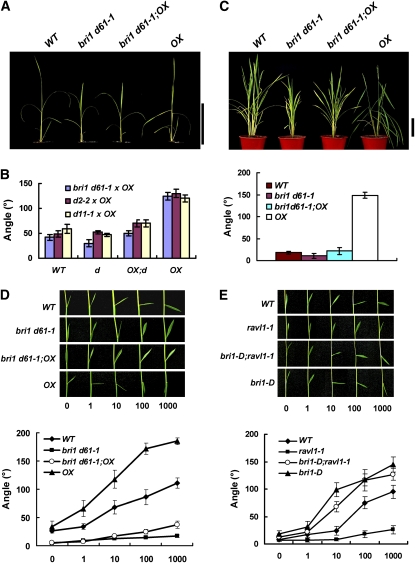Figure 6.
RAVL1 Overexpression in the BR Mutants bri1 d61-1, d2-2, and d11-1 and Lamina Inclination of bri1-D, ravl1-1, and bri1-D;ravl1-1 Plants.
(A) Three-week-old plants are shown from the wild type (WT), bri1 d61-1, OX;bri1 d61-1, and OX. OX indicates RAVL1 overexpressor. Double combinations of the d2-2 and d11-1 mutations with the RAVL1 OX construct are presented in Supplemental Figure 8 online. Bar = 20 cm.
(B) The graph shows the angle of fourth-leaf lamina inclination. Plants were grown for 3 weeks in the greenhouse. Among the 100 to 200 F2 plants examined for each genetic cross, specimens carrying each of the four different genotypes were selected. Mean values are measurements of 5 to 10 plants. Error bars are se of the means.
(C) In the top panel, 2-month-old plants grown in the field are shown: the wild type, bri1 d61-1, OX;bri1 d61-1, and OX. In the bottom panel, the graph shows the lamina angles of the leaf just below the flag (topmost) leaf. Bar = 20 cm.
(D) The lamina inclination assay was performed with wild-type, bri1 d61-1, OX;bri1 d61-1, and OX plants.
(E) The lamina inclination assay was performed with the wild type, ravl1-1, bri1-D, and bri1-D;ravl1-1.
For the lamina inclination assay, the indicated amounts of epiBL in 1 μL of ethanol were spotted on the tip of the second lamina of 6-d-old seedlings (top panels). The graph shows measurements of lamina inclinations in response to epiBL. Mean values are derived from measurements of 10 plants (bottom panels). Error bars are se of the means.

